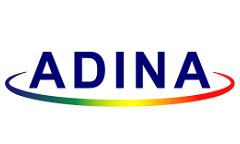发布时间: | 2020-06-02 |  |
来 源: | www.cntech.com | |
相关产品: | ADINA |
1. Introduction
1.1 Objective of this manual
The objective of this manual is to give a concise summary and guide for study of the theoretical basis of the finite element computer program ADINA Solids & Structures (ADINA in short). The program ADINA is used for displacement and stress analysis.
Since a large number of analysis options is available in this computer program, a user might well be initially overwhelmed with the different analysis choices and the theoretical bases of the computer program. A significant number of publications referred to in the text (books, papers and reports) describe in detail the finite element analysis procedures used in the program. However, this literature is very comprehensive and frequently provides more detail than the user needs to consult for the effective use of ADINA. Furthermore, it is important that a user can identify easily which publication should be studied if more information is desired on a specific analysis option.
The intent with this Theory and Modeling Guide is
• To provide a document that summarizes the methods and assumptions used in the computer program ADINA
• To provide specific references that describe the finite element procedures in more detail.
Hence, this manual has been compiled to provide a bridge between the actual practical use of the ADINA system and the theory documented in various publications. Much reference is made to the book Finite Element Procedures (ref. KJB) and to other publications but we endeavored to be specific when referencing these publications so as to help you to find the relevant
information.
ref. K. J. Bathe, Finite Element Procedures, 2nd ed., Cambridge, MA: Klaus-Jürgen Bathe, 2014.
Following this introductory chapter, Chapter 2 describes the elements available in ADINA. The formulations used for these elements have been proven to be reliable and efficient in linear, large displacement, and large strain analyses. Chapter 3 describes the material models available in ADINA. Chapter 4 describes the different contact formulations and provides modeling tips for contact problems. Loads, boundary conditions and constraints are addressed in Chapter 5. Eigenvalue type analyses such as linearized buckling and frequency analyses are described in Chapter 6. Chapter 7 provides the formulations used for static and implicit dynamic analysis, while Chapter 8 deals with explicit dynamic analysis. Several frequency domain analysis tools are detailed in Chapter 9. Fracture mechanics features are described in Chapter 10. Additional capabilities such as substructures, cyclic symmetry, initial conditions, parallel processing and restarts are discussed in Chapter 11. Chapter 12 describes the heat transfer capabilities in the ADINA program. Finally, some post-processing considerations are provided in Chapter 13.
We intend to update this report as we continue our work on the ADINA system. If you have any suggestions regarding the material discussed in this manual, we would be glad to hear from you.
1.2 Supported computers and operating systems
Table 1.2-1 shows all supported computers/operating systems.
1.3 Units
When using the ADINA system, it is important to enter all physical quantities (lengths, forces, masses, times, etc.) using a consistent set of units. For example, when working with the SI system of units, enter lengths in meters, forces in Newtons, masses in kg, times in seconds. When working with other systems of units, all mass and mass-related units must be consistent with the length, force and time units. For example, in the USCS system (USCS is an abbreviation for the U.S. Customary System), when the length unit is inches, the force unit is pound and the time unit is second, the mass unit is lb-sec2 /in, not lb.
Rotational degrees of freedom are always expressed in radians. Most angular input parameters are expressed in degrees.
Table 1.3-1 gives some of the more commonly used unitsneeded for ADINA input.